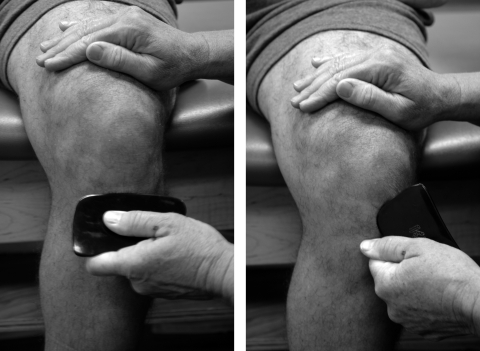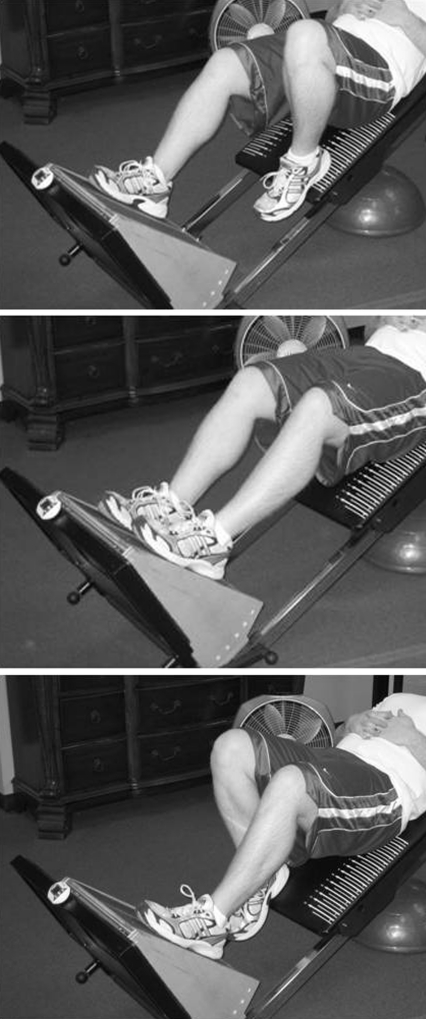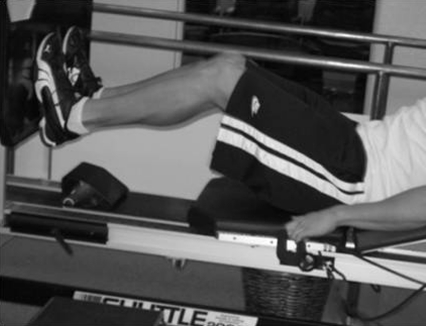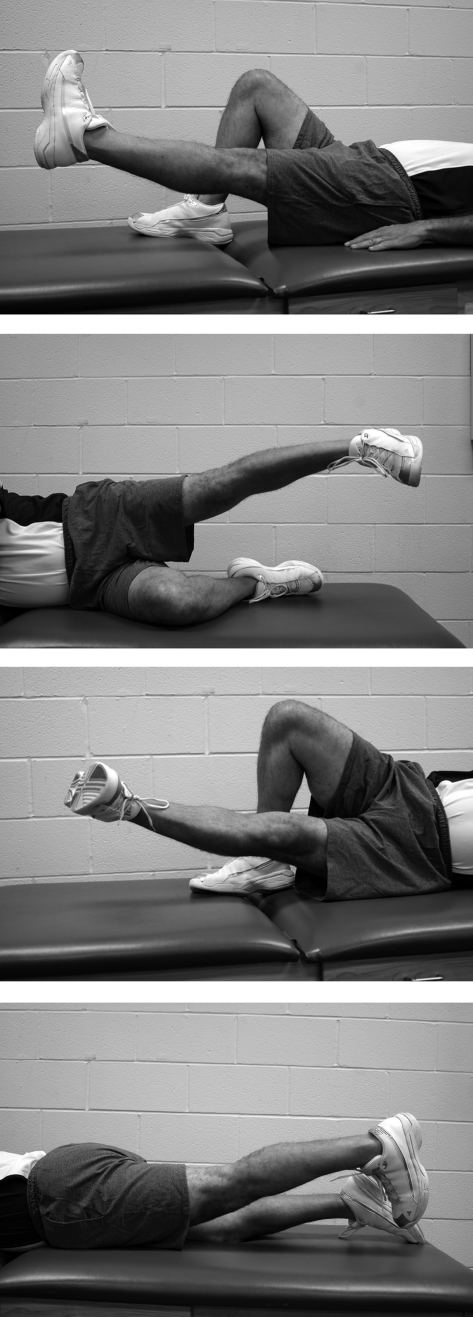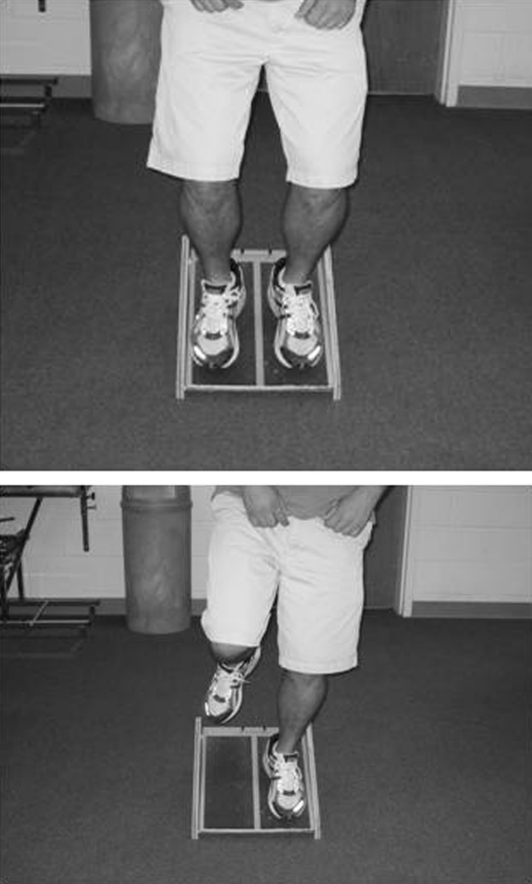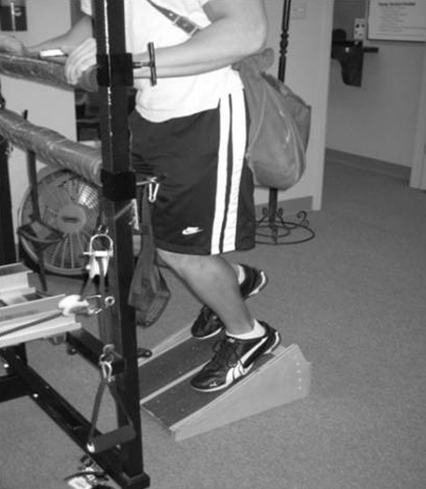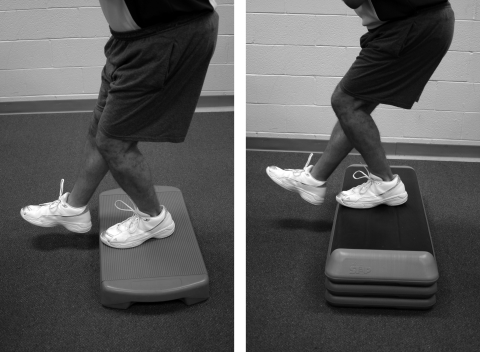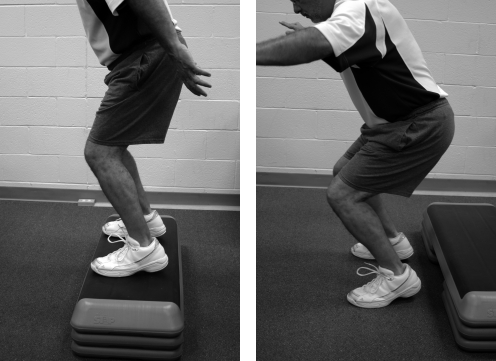Abstract
Chronic tendinopathy is a common musculoskeletal disorder that frequently affects athletes who train and compete at all levels. This Clinical Commentary presents a review of the etiology, incidence, and contributory factors related specifically to patellar tendinopathy. Examination and differential diagnosis considerations are provided, and an evidence-based, staged rehabilitation program is described.
Keywords: Jumper's Knee, patellar tendonitis
INTRODUCTION
Chronic tendinopathy is a common musculoskeletal disorder affecting both recreational and elite athletes potentially leading to disability lasting several months. Overuse tendon injuries account for 7% of the injuries seen in United States physician offices1 and 40% of knee injuries in volleyball players.2 Chronic patellar tendon conditions, also known as patellar tendinosis or “jumper's knee”, are numerous in elite athletes who run and jump as in volleyball (44%) and basketball (32%).3 Similar activity occurs in soccer and dancers, who also participate in repetitive kicking, jumping, and landing.2,3 A higher prevalence is noted in sports with high impact ballistic loading of the knee extensors.3 This disorder is a nemesis in weight lifters due to recurrent heavy load squatting.4 Patellar tendon overuse is also seen in military recruits, accounting for 15% of all of their soft tissue injuries5 and up to 22% incidence in the overall athletic population.3
Microtrauma can occur when the patellar tendon is subjected to extreme forces such as rapid acceleration -deceleration, jumping, and landing.2 The posterior proximal patellar tendon is subjected to greater tensile tendinous forces as compared to the anterior region, especially with jumping activities and deep squat exercises, with forces up to 17 times body weight being placed on the patellar tendon in Olympic weight lifters.2,4,6,7 Patellar tendinopathy occurs more frequently in those skeletally mature adolescents or adults, ranging from ages 16-40 years.8–10 There is disagreement as to whether the incidence is more common in males than females, although recent studies show equal occurrences in both genders.2,11,12 Acute tendinitis involves an active inflammatory process, often occurring following an injury, which if treated, properly heals in 3-6 wks.13 In contrast, chronic patellar tendinopathy, also referred to as patellar tendinosis, manifests itself after 6 wks-3 months as degenerative changes occur in the tendon13,14 These changes include absence of inflammatory cells in the tendon, a tendency toward poor healing, and decreased quality and disorganization of collagen fibers, both of which may lead to decreased tensile strength.13,14 Additionally, neovascularization, the growth of new vasculature in areas of poor blood supply, is common in chronic tendinopathy and may contribute to pain perception.13,15 While the relationship between pain perception and neovascularization is not clearly understood, it is believed that increased levels of the neurotransmitter glutamate may play a role.16 Overuse in athletes who continue to push past pain may contribute to the development of a chronic and problematic condition taking 3-6 months to heal.17
Many factors, both intrinsic and extrinsic, contribute to patellar tendinopathy.11,12 Intrinsic factors such as strength imbalance,1,12 postural alignment,11,12 foot structure,11,12 reduced ankle dorsiflexion,18 and lack of muscle strength or flexibility12 may play a role. However the primary cause appears to relate to the extrinsic factor of overuse. For example, an increased physical load, repetition, intensity, frequency, and or duration of greater than 10% per week in the training schedule all contribute to this overuse syndrome.19 Additionally fatigue, poor technique, and training errors may play a role in this disorder.20,21 Further extrinsic etiologic considerations for injuries may include improper training surfaces, insufficient footwear or inappropriate equipment.20 Progressing physical loading, high intensity training, or repetitive loading too fast may contribute to the development of patellar tendinopathy.20 This microtrauma or “overuse” injury develops from repetitive mechanical loading of the tendon through excessive jumping and landing activity. Training duration within a session or a season is the most common reason for overuse.21 Drastic changes in frequency and or intensity of training may also lead to overuse training errors.19 A general rule of thumb for acceptable progression of training is a 10% increase in intensity, duration, and frequency per week.19
EVALUATION
The purpose of the evaluation is to differently diagnose between conditions affecting the patella. A comprehensive evaluation includes detailed examination of both intrinsic and extrinsic factors. A detailed history of a patient's workout schedule and duration of symptoms is paramount to making a correct diagnosis. If symptoms have lasted longer than 6 weeks, tendinopathy should be suspected. Evaluation of chronic patellar tendinopathy should include the utilization of Blazina's knee scale22 or Kennedy's scale23 (Table 1) which both assist the rehabilitation professional to gauge the severity of the tendinopathy. Patients with patellar knee pain may grade pain as general achiness after activity (Blazina Stage 1) to pain during and after activity which interferes with competition (Blazina Stage 3). Total tendon disruption is present in Blazina Stage 4.22
Table 1.
Scales to assist in evaluating patellar tendinopathy.
| PHASES | BLAZINA JUMPER'S KNEE SCALE | KENNEDY TENDINOPATHY STAGES |
|---|---|---|
| PHASE 1 | Pain after activity only | Pain after activity |
| PHASE 2 | Pain/discomfort during and after activity with the subject still able to perform at a satisfactory level (does not interfere with participation) | Pain at the beginning and after activity |
| PHASE 3 | Pain during and after activity with more prolonged, with subject having progressively increasing difficulty in performing at a satisfactory level (interferes with competition) | Pain at the beginning, during, and after activity, but the performance is not affected |
| PHASE 4 | Complete tendon disruption | Pain at the beginning, during and after activity, and the performance is affected |
Physical examination during all stages reveals tenderness to palpation and pain over the inferior pole of the patella24 and possibly in the body of the tendon.24 Thickness of the tendon may be noted also in all stages, but it is rare to see effusion. Pain in the patellar tendon may be reproduced with resisted knee extension.24 Additional functional tests of ascending or descending stairs, performing single leg declining squats, jumping or hopping will most likely reproduce patellar pain symptoms.25 Patients such as weight lifters may complain of a “giving way” or a perception that knee will “buckle” under load as well as stiffness or achiness after activity.22 Additionally, they may complain of stiffness or achiness after activity (Blazina stage 3 or Kennedy Stage 4).
The evaluation should include history, age and any recent growth spurts, location of pain, and special tests. The rehab professional should be able to differentiate between patellar tendinopathy and additional diagnoses of 1) patellofemoral dysfunction (more diffuse patellar pain),12 2) Sinding-Larsen-Johansson Syndrome(skeletally immature adolescents with pain in the inferior pole of the patella),26 and 3) Osgood Schlatter's disease (skeletally immature adolescents with pain at the attachment of patellar tendon at the tibial tubercle with possible tibial tubercle enlargement).10
REHABILITATION
Stage 1: Initial Rehabilitation Controlled Rest
Controlled rest is critical in the recovery of patellar tendinopathy. During this phase of rehabilitation, the athlete should refrain from sports activity or abstain from the overuse abuse, and practice controlled exercise without load.11,27 During this phase, patient education regarding activity is paramount. It is critical to recovery to avoid jumping or deep squatting (Table 2). Progressing to relatively pain free activities, such as stationary cycling, performing exercises on a Total Gym®, or working in an aquatic environment can help maintain physical stamina, and yet unload the tendon. Kennedy et al23,28 suggested subjects with pain in stage 1 tendinopathy (pain only after activity) or stage 2 (pain during and after activity) adapt their training schedule, whereas subjects in stage 3 (pain during and after workouts that affects performance) may need total rest from aggravating activities. The athlete in stage 3 may still exercise aerobically, but must avoid irritating activities.23,28 Visnes et al29 reported that volleyball players who continued to train and compete during an eccentric rehabilitation exercise program showed no benefit from rehabilitation exercises. Therefore, Visnes et al29 suggested that patients be removed from sports participation while undergoing an eccentric-only rehabilitation program, then resume competitive sports training after 8 weeks, with a gradual return to sporting activity over the next 4 weeks.29,30
Table 2.
Progression of rehabilitation exercises for patellar tendinopathy.
| Week | Rest | Eccentric Exercise | Transverse friction mobilization | Stretching(30 sees × 3-4x) |
|---|---|---|---|---|
| 1 | *No jumping or running; can ride bike, do pool work; | *Around the world eccentric lowering leg raises(4 way) increase weight by 1# each week) | 5-10 minutes firmly 1-2x a day | Hip flexors, quadriceps, hamstrings, & heelcords before/ after activity |
| *No sports specific training | *Eccentric squats on Total Gym/Shuttle on decline board 15 reps × 3 sets 1-2 × a day/ | |||
| 2 | *No jumping or running; can ride bike, do pool work; | *Around the world eccentric lowering leg raises(4 way) increase weight by 1# each week) | 5-10 minutes firmly 1-2× a day | Continue stretching as above |
| *No sports specific training | *Eccentric squats on Total Gym/Shuttle on decline board 15 reps × 3 sets 1-2× a day/ | |||
| 3 | *Begin jumping squats in short range on Total gym/Shuttle; | *Around the world eccentric lowering leg raises(4 way) (increase weight by 1# each week) | 5-10 minutes firmly 1-2× a day | Continue stretching as above |
| *No sports specific training | *Eccentric squats on Total Gym/Shuttle on decline board 15 reps × 3 sets 1-2 × a day/; | |||
| *Progress to upright decline board squats | ||||
| 4 | *cycle, exercise in water; | *Upright squats on decline board double leg to single leg; add 10# to backpack; | As needed | Continue stretching as above |
| *Begin eccentric step downs standing (no step) | * Around the world eccentric lowering leg raises(4 way) (increase weight by 1# each week) | |||
| *No sports specific training | ||||
| 5 | Begin eccentric step downs on 4″ step; | *Upright squats on decline board double leg to single leg; add 20# to backpack; | As needed | Continue stretching as above |
| *No sports specific training | *Continue Around the world eccentric lowering leg raises(4 way) (increase weight by 1# each week) | |||
| *Begin jumping squats on Total Gym/Shuttle with both legs | ||||
| 6 | *Begin eccentric step downs on 6"; | "Upright squats on decline board double leg to single leg; add 30# to backpack; | As needed | Continue stretching as above |
| *No sports specific training | * Continue Around the world eccentric lowering leg raises(4 way) (increase weight by 1# each week) | |||
| * Jumping squats on Total Gym/Shuttle with both legs | ||||
| 7 | *Begin eccentric step downs on 8″ step | *Upright squats on decline board double leg to single leg; add 40# to backpack; | As needed | Continue stretching as above |
| *Continue leg lifts with weights; | ||||
| * Jumping squats on Total Gym/Shuttle with single leg | ||||
| 8-12 | *Progressive return to jumping/ squatting/jump boxes; | *Jumping squats on Total *Gym/Shuttle with single leg; | As needed | Continue stretching as above |
| *Begin sports specific training with gradual return to sporting events | *Upright squats on decline board with 50#' | |||
| "Jumping squats one leg on Total gym/Shuttle with maximal resistance |
Interventions
Rehabilitation incorporates three stages ranging from limited partial weight bearing loaded exercise to a sports specific return to play protocol. Since overuse is a primary contributor to patellar tendinopathy, it is important to avoid rapid progression in frequency, intensity, and duration in rehabilitation and functional progression.19 Since most athletes with patellar tendinopathy are treated non-operatively,31 it is imperative to understand rehabilitation protocols and implement them wisely. Eccentric exercise has been promoted as an important conservative treatment choice for patellar tendinopathy2,32,33,34,35,36 as well as for Achilles tendinopathy.37,38 However, a variety of protocols have been implemented for rehabilitation intervention.2,25,32–37 For example, the Alfredson protocol37 of eccentric exercise intensity to pain level up to 5/10 directly contrasts the early work of Stanish and Curwin34 who suggest that exercise only be performed without pain. Because no standard rehabilitation protocol has been established as it relates to pain symptoms secondary to tendinopathy, the following protocol has been developed by this author, involving a pain-free intervention progressing from partial body weight to full body weight positions.
Initial treatment for patellar tendinopathy includes the following: absence from jumping, relative rest (absence of abuse),27 stretching of lower extremity musculature, deep transverse friction massage of the patellar tendon, eccentric quadriceps exercises, strengthening of hip and knee musculature, utilization of a patellar orthotic (if needed), and cryotherapy. Since patellar tendinosis is a chronic, non-acute condition, inflammation is absent. Thus, anti-inflammatory medications (NSAIDs) are seldom effective.39 Additionally, the use of cortisone injections may negatively affect tendon strength and may possibly result in tendon rupture.16
Prior to initiating exercise, a warm-up and stretching period is recommended.38 Cycling on a stationary bicycle for 5-10 minutes with minimal resistance is suggested as an active warm-up. Next, stretching should be incorporated into the program before and after the exercise routine in order to address any flexibility imbalances (Table 2). Hip flexor, quadricep, hamstring, and gastrocnemius and soleus tightness may contribute to tendon overload during jumping and landing activities.12 Lower extremity stretching of 15, 30, 45, or 60 seconds or 2 minutes produces significant gains in flexibility in healthy young or middle age adults.40,41 Static stretching of 30 seconds at least three to four times per day is recommended by various authors.34,40,41
Soft tissue mobilization (STM) is used to reduce pain and fibrotic limitations in tissue found in patellar tendinopathies.42 Deep transverse friction massage for 5-10 minutes twice daily is recommended to help promote normalized collagen alignment.43–45 Hunter found that firm pressure during cross friction massage is more effective than light to moderate pressure.43,44 Use of a rigid instrument, such as a stainless steel or hard plastic tool, may provide accelerated early tissue level healing in ligamentous and tendinous injuries (Figure 1).45,46 Furthermore, STM applied transversely to the line of collagen fibers while the tissue is placed under tension may assist damaged tissue to regain tensile strength and proper fiber orientation in the early stages of healing.44 Patients can be educated to perform STM daily until tissue is normalized and pain is absent with palpation.
Figure 1.
Soft tissue mobilization. 1a: Deep friction with use of device (longitudinally). 1b: Deep friction with use of device (cross-friction).
Eccentric exercises play an important role in chronic patellar tendinopathy rehabilitation. Performing eccentric squats on a 25° decline board for 3 set of 15 repetitions twice daily is suggested.2,22,23,25,36,37,47 Loading a tendon in a controlled environment free from overuse with progressive stress improves tendon function.31 A controlled tendon loading exercise program can be initiated through utilization of a Total Gym® (Figure 2), Shuttle® (Figure 3), or a pool. Using a decline board, more specifically targets the patellar tendon (25-30% higher patellar tendon forces)35 as compared to squats performed on flat surfaces which more likely targets the quadriceps muscle. This specificity of tendon training allows the patient to progress faster than on a squat on flat surface secondary to a better isolation of the knee extensor mechanism. The patient performs partial weight bearing eccentric squats in a pain-free range of motion by placing a 25° decline board on a Total Gym® (Figure 2) or Shuttle® (Figure 3). Progression occurs as the angle of the Total Gym® or the resistance on the Shuttle® is increased. Likewise, a similar approach can be used in the pool with a decline board on the pool floor in shoulder deep water. Progression occurs from moving to waist deep water, then shallower hip deep water.
Figure 2.
2a: Patient initiates knee extension concentrically by extending the unaffected extremity. 2b: Progression to bilateral eccentric lowering with both lower extremities 2c: Progression to full weight bearing on the affected extremity eccentrically descends to at least a 60° angle.
Figure 3.
Unloaded squats can be performed on a Shuttle®. If significant pain with eccentric lowering, eccentric squats can performed bilaterally.
A patient is ready to progress when they can easily complete the 3 sets of 15 repetitions of eccentric squats on a decline board pain-free. As one improves, decline squats can increase in difficulty from bilateral eccentric to unilateral eccentric, then to concentric-eccentric contractions,37,49 During the concentric phase of the squatting motion, initially one should use the unaffected leg to extend the knee, then lower eccentrically bilaterally; progressing to single limb eccentrics using the affected leg. Additionally, speed should be addressed throughout rehabilitation. Bilateral slow speed decline squats are encouraged during the first week of rehabilitation while faster speeds are encouraged during the second week. Although pain reported by the patient of up to level 5/10 on the Visual Analog Scale is common with some of the documented eccentric progressions of exercise,37,49 other authors have found exercising without induced pain to be beneficial to healing.34,50 This non-painful protocol may benefit the non-athlete as well. Sayana et al50 found only 56% of non-athletic subjects benefitted from full weight bearing eccentric painful squat exercises. Therefore, this pain-free protocol is recommended by the author of this commentary for all individuals with patellar tendinopathy.
Squatting depths are controversial among health professionals and coaching instructors. Squatting should be limited to no greater than 60-70° knee flexion51,52,53 due to the excessive forces on the patellofemoral joint, patellar tendon, and the meniscus, although some studies encourage full depth squats to 90 degrees.30,36 Other patellar tendinopathy protocols36,53 had subjects performing squats slowly to 60° and 70° knee flexion respectively. Dillon et al52 found significantly greater forces on the posterior fascicles of the patellar tendon between 60-90° of squatting. Squatting depths can be easily controlled on a Total gym®, Shuttle®, or in the upright, full-weightbearing position.
A proximal hip and thigh strengthening program including “around the world” leg raises (straight leg raises, sidelying hip abduction /hip adduction and prone hip extension) with concentration on eccentric lowering is important (Figure 4). Hip strengthening exercise with a 2 second concentric leg lift, followed by a 4 sec eccentric leg lowering is encouraged. Hip strengthening exercises (with no weight initially) combined with the decline eccentric squats should be an essential element of injury and rehabilitation programs.55–57 Education of the patient to perform exercises at home is also key to full recovery.
Figure 4.
“Around the World” leg raises. 4a. Straight leg raise 4b. Hip Abduction side leg raise 4c. Hip adduction inside leg raise 4d. Hip extension prone leg raise.
Although ice has been shown to reduce inflammation in acute conditions, varied results are found with the use of ice in chronic conditions.34,58 Ice massage for 5 minutes or ice pack to the patellar tendon can be applied for up to 10 minutes following the exercise program.34 Knobloch et al58 found intermittent cryotherapy of 3 sets of 10 minutes significantly decreased local Achilles tendon mid-portion capillary blood flow by 71%, thus promoting venous capillary outflow in the tendon. Many common modalities, such as iontophoresis,59 ultrasound,60,61 and electrical stimulation62,63 have not been found to be effective in treatment of chronic tendinopathy. Extracorporeal shock wave therapy (ESWT) for patellar tendinopathy shows promise as a safe treatment based upon a literature review of seven studies, although no specific treatment regime is recommended.64 A systematic review of low level laser treatment (LLLT) shows potential effectiveness for treating tendinopathy when recommended dosages are used.65
Orthotics or taping may be beneficial for patellar tendinosis. The Chopat® strap, or other varied patellar tendon straps can help stabilize the tendon with jumping activities, and may be used during rehabilitation. Although various authors25,66–68 suggest use of such orthotics, no randomized controlled trials have been conducted examining their efficacy in patellar tendinosis, and therefore evidence is lacking to the effectiveness of a patellar strap. Further research need to be conducted regarding the use of such devices.
Stage 2: Progression
After pain symptoms decrease, progress the patient to upright 258 decline eccentric squats (3 sets of 15 repetitions twice daily), utilizing the bilateral- unilateral- eccentric-concentric progression as outlined previously. The eccentric exercise program should be progressed from partial-weight bearing to full weight bearing (Figure 5), then to weighted resistance using a back pack or weighted vest (Figure 6). Speed can be increased during the concentric-eccentric phase, finally progressing to more ballistic type activity (jump squats) to prepare for return to functional activities. Once symptoms have subsided, patients with tendinopathy should be encouraged to continue eccentric strengthening exercise even after their return to sport.
Figure 5.
Decline squats. 5a. Ascending to upright can be performed with the majority of weight on the unaffected leg. 5b.Upon descent, full weight is placed on the affected extremity as the patient eccentrically lowered to at least a 60° angle.
Figure 6.
To progress patient, add weighted backpack.
As previously mentioned, resistance weight may be added to the single squat eccentrics, either through a weighted belt, vest or bag, or by using a backpack with weights. Once the subject can perform decline squats easily and without pain, weights can be added in 5 kg increments, starting with 10% of body weight.29,53 Double leg jumping squats on the Shuttle® or Total gym® may be initiated at weeks 4-5 at a progressive resistance level that does not produce patellar pain. The stretching program as well as the “around the world” leg raise routine using progressive ankle weights (1-2# per week) should be continued. Additionally, deep-friction massage and ice following exercise should be maintained. At 4 weeks, slow pain-free jogging on flat ground, as well as resisted cycling or water jogging can be added.30
Avoidance of sports activity during the first 8 weeks is crucial for continued healing. Those who have continued to train and compete in sports activities during treatment progression have demonstrated little change in prognosis.29
Stage 3: Sports Specific: Return to Play
In this phase, the athlete should continue the above routine, adding more weight in 5 kg increments with the weighted eccentric decline squats. Progression to a drop squat, involving rapidly eccentrically dropping into a stationary squat position, should include 3 sets of 20 reps with incremental weight as above.69 Three sets of 15 repetitions daily of eccentric step downs off of 4″, 6″ and 8″ height steps performed with minimal to no discomfort are appropriate as well (Figure 7).54 Jumping activities can then be added to this routine. Progression of double leg jumping squats (involving concentric and eccentric jumping in a squat position repetitively) on the Shuttle® or Total gym® to a single leg jump should be initiated before beginning standing jumps. Following pain-free movement off of the 6-8″ step down, progress to drop jumps.34,69 Progression includes drop jumping off small step (4″), progressing to 6″ and 8″ steps when 3 sets of 20 repetitions daily are easy (Figure 8)34,69 Forward and backward hop jumps, side to side jumps, jumping rope, and run and turn activities such as figure of 8's are all functional activities athletes should perform. Additionally, running and kicking may be incorporated in this stage. Education regarding exercise activity should include performance of exercises above at home or the gym, and avoidance of training on concrete surfaces.
Figure 7.
Step Downs. 7a. Step down off 4″ step. 7b. Step down off 8″ step.
Figure 8.
“Jump downs” off step. 8a. Beginning position of “jump downs” 8b. Landing of “jump down”.
SUMMARY
While various rehabilitation techniques exist to treat patellar tendinopathy, eccentric exercise has been found to be safe and effective29,30,36,53 and should be included as part of the comprehensive rehabilitation of this pathology. Additionally, deep transverse friction massage, strengthening of the hip musculature and stretching are all suggested initially and throughout the recovery of this type of injury. The protocol presented in this commentary uses partial body weight decline eccentric squats as the initial exercise prior to progressing to upright, fully loaded decline squats. The rehabilitation specialist should include eccentric squats in a “safe” 60-70 degree knee flexion range on a decline board progressing from the partially loaded position to the upright position at a dosage of 3 sets of 15 repetitions twice daily for 12 weeks. Progressive jumping activities are added midway through the program. Other considerations may include slow progression back to sporting events after 2-3 months, assuming the tendon site is pain-free in all activities.
A variety of rehabilitation techniques are necessary to assist an individual in returning to recreational activities following patellar tendinopathy. A combination of active rest, education, eccentric exercise, progressing the training regime by 10% weekly, and modifying activity have all been found to be effective in tendinopathy treatment.19,70
REFERENCES
- 1.Woodwell DA, Cherry DK. National Ambulatory Medical Care Survey; 2002 summary. Adv Data. 2004;346:1–44 [PubMed] [Google Scholar]
- 2.Ferretti A, Conteduca F, Camerucci E, Morelli F. Patellar tendinosis: A follow-up study of surgical treatment. J Bone Joint Surg. 2002;84A(12):2179–85 [PubMed] [Google Scholar]
- 3.Lian OB, Engebretsen L, Bahr R. Prevalence of jumper's knee among elite athletes from different sports. Am J Sports Med. 2005;33(4):561–67 [DOI] [PubMed] [Google Scholar]
- 4.Khan KM, Maffulli N, Coleman BD, Cook JL, Taunton JE. Patellar tendinopathy” some aspects of basic science and clinical management. Br J Sports Med. 1998;32(4):346–55 [DOI] [PMC free article] [PubMed] [Google Scholar]
- 5.Linenger JM, West LA. Epidemiology of soft tissue/musculoskeletal injury among US Marine recruits undergoing basic training. Mil Med. 1992;157:491–3 [PubMed] [Google Scholar]
- 6.Dillon EM, Erasmus PJ, Müller JH, et al. Differential forces within the proximal patellar tendon as an explanation for the characteristic lesion of patellar tendinopathy: an in vivo descriptive experimental study. Am J Sports Med. 2008;36(11):2119–27 [DOI] [PubMed] [Google Scholar]
- 7.Lavagnino M, Arnoczky SP, Elvin N, et al. Patellar tendon strain is increased at the site of the jumper's knee lesion during knee flexion and tendon loading: results and cadaveric testing of a computational model. Am J Sports Med. 2008;36(11):2110–8 [DOI] [PubMed] [Google Scholar]
- 8.Cook JL, Kiss ZS, Khan KM, Purdam DR, Webster KE. Antroprometry, physical performance, and ultrasound patellar tendon abnormality in elite junior basketball players: a cross-sectional study. Br J Sports Med. 2004;38(2):206–09 [DOI] [PMC free article] [PubMed] [Google Scholar]
- 9.Cook JL, Khan KM, Kiss ZS, Griffiths L. Patellar tendinopathy in junior basketball players: a controlled clinical and ultrasonographic study of 268 patellar tendons in players aged 14-18 years. Scand J Med & Sci Sports 2008;10(4):216–20 [DOI] [PubMed] [Google Scholar]
- 10.Patellar tendinitis jumper's knee. Wheeless' Textbook of Orthopaedics. www.wheelessonline.com/ortho/patellar tendinitis jumpers knee Accessed 3/23/07.
- 11.Cook JL, Khan KM, Maffulli N, et al. Overuse tendinosis, not tendinitis. part 2: applying the new approach to patellar tendinopathy. The Phys and Sportsmedicine. 2000;28(6):1–11 [DOI] [PubMed] [Google Scholar]
- 12.Witvrouw E, Bellemans J, Lysens, et al. Intrinsic risk factors for the development of patellar tendinitis in an athletic population: a two-year prospective study. Am J Sports Med. 2001;29(2):190–95 [DOI] [PubMed] [Google Scholar]
- 13.Maffulli N, Wong J, Almekinders LC. Types and epidemiology of tendinopathy. Clin Sports Med. 2003;22(4):675–92 [DOI] [PubMed] [Google Scholar]
- 14.Cook JL, Khan KM, Purdam CR. Conservative treatment of patellar tendinopathy. Phys Ther in Sport. 2001;35(5):291–94 [DOI] [PMC free article] [PubMed] [Google Scholar]
- 15.Ohberg L, Lorentzon R, Alfredson H. Neovascularisation in Achilles tendons with painful tendinosis but not in normal tendons: an ultrasonographic investigation. Knee Surg Sports Traumatol Arthrosc. 2001;9(4):233–38 [DOI] [PubMed] [Google Scholar]
- 16.Alfredson H. The chronic painful Achilles and patellar tendon: research on basic biology and treatment. Scand J Med Sci Sports. 2005;15(4):252–9 [DOI] [PubMed] [Google Scholar]
- 17.Wilson JJ, Best TM. Common overuse tendon problems: a review and recommendations for treatment. Am Family Phys. 2005;72(5):811–18 [PubMed] [Google Scholar]
- 18.Malliaras P, Cook JL, Kent P. Reduced ankle dorsiflexion range may increase the risk of patellar tendon injury among volleyball players. J Sci Med Sport. 2006;9(4):304–9 [DOI] [PubMed] [Google Scholar]
- 19.Matava MD. American Orthopedic Society for Sports Medicine. 2008. http://www.sportsmed.org/secure/reveal/admin/uploads/documents/ST%20Overuse%20Injuries%2008.pdf Accessed 4/4/10. [Google Scholar]
- 20.Magra M, Maffulli N. Genetic aspects of tendinopathy. J Sci and Med Sport. 2008;11(3):243–47 [DOI] [PubMed] [Google Scholar]
- 21.Almekinders LC, Temple JD. Etiology, diagnosis, and treatment of tendonitis: an analysis of the literature. Med Sci Sports Exerc. 1998;30(8):1183–90 [DOI] [PubMed] [Google Scholar]
- 22.Blazina ME, Kerlan RK, Jobe FW, Carter VS, Carlson GJ. Jumper's knee. Orthop Clin of North Am. 1973;4(3):665–78 [PubMed] [Google Scholar]
- 23.Kennedy JC, Hawkins R, Krissoff WB. Orthopaedic manifestations of swimming. Am J of Sports Med. 1978;6(6)309–21 [DOI] [PubMed] [Google Scholar]
- 24.Cook JL, Khan KM, Kiss ZS, Purdam DR, Griffiths L. Reproducibility and clinical utility of tendon palpation to detect patellar tendinopathy in young basketball players. Br J Sports Med. 2001;35(1):65–69 [DOI] [PMC free article] [PubMed] [Google Scholar]
- 25.Purdam DR, Cook JL, Hopper DM, Khan KM, et al. Discriminative ability of functional loading tests for adolescent jumper's knee. Phys Ther in Sport. 2003;4(1):3–9 [Google Scholar]
- 26.Medlar RC, Lyne ED. Sinding-Larsen-Johansson disease. Its etiology and natural history. J Bone Joint Surg Am. 1978;60:1113–16 [PubMed] [Google Scholar]
- 27.Nirschl RP. Elbow tendinosis/tennis elbow. Clin Sports Med. 1992;11(4):851–70 [PubMed] [Google Scholar]
- 28.Hawkins RJ, Kennedy JC. Impingement syndrome in athletes. Am J Sports Med. 1980;8(3):151–58 [DOI] [PubMed] [Google Scholar]
- 29.Visnes H, Bahr R. The evolution of eccentric training as treatment for patellar tendinopathy (jumper's knee): a critical review of exercise programmes. Br J Sports Med. 2007;41(4):217–23 [DOI] [PMC free article] [PubMed] [Google Scholar]
- 30.Purdam CR, Johsson P, Alfredson H, et al. A pilot study of the eccentric decline squat in the management of painful chronic patellar tendinopathy. Br J Sports Med. 2004;38(4):395–97 [DOI] [PMC free article] [PubMed] [Google Scholar]
- 31.Kettunen JA, Kvist M, Alanen E, et al. Long-term prognosis for jumper's knee in male athletes. Am J Sports Med. 2002;30(5):689–92 [DOI] [PubMed] [Google Scholar]
- 32.Kongsgaard M, Aagaard P, Roikjaer S, et al. Decline eccentric squats increases patellar tendon loading compared to standard eccentric squats. Clin Biomech. 2006;21(7):748–54 [DOI] [PubMed] [Google Scholar]
- 33.Bahr R, Fossan B, Loken S, et al. Surgical treatment compared with eccentric training for patellar tendinopathy (jumper's knee). J Bone Joint Surgery. 2006;88(8):1689–98 [DOI] [PubMed] [Google Scholar]
- 34.Stanish WD, Rubinovich RM, Curwin S. Eccentric exercise in chronic tendinitis. Clin Orthop Relat Res 1986;208:65–8 [PubMed] [Google Scholar]
- 35.Frohm A, Saartok T, Halvorsen K, Renstrom P. Eccentric treatment for patellar tendinopathy: a prospective randomised short-term pilot study of two rehabilitation protocols. Br J Sports Med. 2007;41;e7. [DOI] [PMC free article] [PubMed] [Google Scholar]
- 36.Jonsson P, Alfredson H. Superior results with eccentric compared to concentric quadriceps training in patients with jumper's knee: a prospective randomised study. Br J Sports Med. 2005;39(11):847–50 [DOI] [PMC free article] [PubMed] [Google Scholar]
- 37.Alfredson H, Peitila T, Jonsson P, Lrentzon R. Heavy-load eccentric calf muscle training for the treatment of chronic Achilles tendinosis. Am J Sports Med. 1998;26:360–66 [DOI] [PubMed] [Google Scholar]
- 38.Alfredson H, Cook J. A treatment algorithm for managing Achilles tendinopathy: new treatment options. Br J Sports Med. 2007;41(4):211–16 [DOI] [PMC free article] [PubMed] [Google Scholar]
- 39.Alfredson H, Dimmen S. Non-Steroidal anti-inflammatory drugs and tissue healing. Mini symposium. Presented at the 12th ESSKA Congress and 5th World Congress on Sports Trauma. May 24-27, 2006. Innsbruck Austria. Accessed at www.Orthosupersite.com/print.asp?rID=18588 on 11/20/06.
- 40.Youdas JW, Krause DA, Egan KS, et al. The effect of static stretching of the calf muscle-tendon unit on active ankle dorsiflexion range of motion. J Orthop Sports Phys Ther. 2003;33(7):408–17 [DOI] [PubMed] [Google Scholar]
- 41.Bandy W, Irion JM, Briggler M. The effect of time and frequency of static stretch on flexibility of the hamstring muscle. Phys Ther. 1997;77:1090–96 [DOI] [PubMed] [Google Scholar]
- 42.Croisier JL. Factors associated with recurrent hamstring injuries. Sports Med. 2004;34(10):681–95 [DOI] [PubMed] [Google Scholar]
- 43.Hunter G. Specific soft tissue mobilisation in the treatment of soft tissue lesions. Physiother. 1994;80(1):15–21 [Google Scholar]
- 44.Hunter G. The conservative management of Achilles tendinopathy. Phys Ther in Sport. 2000;1:6–14 [Google Scholar]
- 45.Gehlsen GM, Ganion LR, Helfst R. Fibroblast responses to variation in soft tissue mobilization pressure. Med Sci Sports Exerc. 1999;31(4):531–35 [DOI] [PubMed] [Google Scholar]
- 46.Loghmani MT, Warden SJ. Instrument- Assisted Cross Fiber Massage Accelerates Knee Ligament Healing. J Ortho Sports Phys Ther. 2009;39(7):506–14 [DOI] [PubMed] [Google Scholar]
- 47.Da Silva CQ, Cotte R, Vicard L, et al. Interest of eccentric isokinetic exercises in cases of calcanean tendinosis and thigh muscular injuries: prospective study results. Isokinetics Ex Sci. 2005;13:39–44 [Google Scholar]
- 48.Wang JH, Iosifidis MI, Fu FH. Biomechanical basis for tendinopathy. Clin Orthop Relat Res. 2006;443:320–32 [DOI] [PubMed] [Google Scholar]
- 49.Silbernagel KG, Thomee R, Thomee P, et al. Eccentric overload training for patients with chronic Achilles tendon pain-a randomized controlled study with reliability testing of the evaluation methods. Scand J Med Sci Sports. 2001;11(4):197–206 [DOI] [PubMed] [Google Scholar]
- 50.Sayana MK, Maffulli N. Eccentric calf muscle training in non-athletic patients with Achilles tendinopathy. J Sci Med Sports. 2007;10(1):52–58 [DOI] [PubMed] [Google Scholar]
- 51.Zwerver J, Bredeweg SW, Hof AL. Biomechanical analysis of the single-leg decline squat. Br J Sports Med. 2007;41(4):264–68 [DOI] [PMC free article] [PubMed] [Google Scholar]
- 52.Dillon EM, Erasmus PJ, Muller JH, et al. Differential forces within the proximal patellar tendon as an explanation for the characteristic lesion of patellar tendinopathy: an in vivo descriptive experimental study. Am J Sports Med. 2008;36(11):2119–27 [DOI] [PubMed] [Google Scholar]
- 53.Young MA, Cook JL, Purdam CR, et al. Eccentric decline squat protocol offers superior results at 12 months compared with traditional eccentric protocol for patellar tendinopathy in volleyball players. Br J Sports Med. 2005;39(4):102–5 [DOI] [PMC free article] [PubMed] [Google Scholar]
- 54.Basso O, Amis AA, Race A, et al. Patellar Tendon Fiber Strains: Their Differential Responses to Quadriceps Tension Basso. Clin Orthop Relat Res. 2002; July (400):246–53 [DOI] [PubMed] [Google Scholar]
- 55.Bolgla LA, Shaffer SW, Malone TR. Vastus medialis activation during knee extension exercises: evidence for exercise prescription. J Sport Rehabil. 2008;17(1):1–10 [DOI] [PubMed] [Google Scholar]
- 56.Distefano LG, Blackburn JT, Marshall SW, et al. Gluteal Muscle Activation During Common Therapeutic Exercises. J Ortho Sports Phys Ther. 2009;39(7):532–40 [DOI] [PubMed] [Google Scholar]
- 57.Ireland ML, Willson JD, Ballantyne B, et al. Hip strength in females with and without patellofemoral pain. J Orthop Sports Phys Ther. 2003;33(11):671–76 [DOI] [PubMed] [Google Scholar]
- 58.Knoblach K, Schreibmueller, Kraemer R, et al. Eccentric training and an Achilles wrap reduce Achilles tendon capillary blood flow and capillary venous filling pressures and increase tendon oxygen saturation in insertional and midportion tendinopathy, a randomized trial. Am J Sports Med. 2007;10(10):1177–86 [DOI] [PubMed] [Google Scholar]
- 59.Runeson L, Haker E. Iontophoresis with cortisone in the treatment of lateral epicondylalgia (tennis elbow)–a double-blind study. Scand J Med Sci Sports. 2002;12(3):136–42 [DOI] [PubMed] [Google Scholar]
- 60.Bisset L, Paungmali A, Vicenzino B, Beller E. A systematic review and meta-analysis of clinical trials on physical interventions for lateral epicondylalgia. Br J Sports Med. 2005;39(7):411–22 [DOI] [PMC free article] [PubMed] [Google Scholar]
- 61.Mayer F, Hirschmuller A, Muller S, Schubert M, Baur H. The effects of short term treatment strategies over 4 weeks in Achilles tendinopathy. Br J Sports Med. 2007;41(7):e6. [DOI] [PMC free article] [PubMed] [Google Scholar]
- 62.Devereaux M, Hazleman B, Thomas P. Chronic lateral humeral epicondylitis: a double-blind controlled assessment of pulsed electromagnetic field therapy. Clin Exp Rheumatol. 1985;3:333–36 [PubMed] [Google Scholar]
- 63.Michlovitz SL. Is there a role for ultrasound and electrical stimulation following injury to tendon and nerve? J Hand Ther. 2005;18(2):292–96 [DOI] [PubMed] [Google Scholar]
- 64.Von Leeuwen MT, Zwerver J, van den Akker-scheek I. Extracorporeal shockwave therapy for patellar tendinopathy: a review of the literature. Br J Sports Med. 2009;43(3):163–8 [DOI] [PubMed] [Google Scholar]
- 65.Tumility S, Munn J, McDonough S, Hurley DA, Basford JR, Baxter GD. Low level laser treatment of tendinopathy: a systematic review with meta-analysis. Photomed Laser Surg. 2010;28(1):3–16 [DOI] [PubMed] [Google Scholar]
- 66.Adirim TA, Cheng TL. Overview of Injuries in the Young Athlete. Sports Med. 2003;33(1):75–81 [DOI] [PubMed] [Google Scholar]
- 67.Greene BL. Physical therapist Management of Fluoroquinolone Induced Achilles Tendinopathy. Phys Ther. 2002;82(12):1224–31 [PubMed] [Google Scholar]
- 68.Braverman SE. Orthotics for the Fighting Forces. Phys Med Rehabilitation Clinics North America. 2002;31(1):159–73 [DOI] [PubMed] [Google Scholar]
- 69.Cannell LJ, Taunton JE, Clement DB, et al. A randomised clinical trial of the efficacy of drop squats or leg extension/leg curl exercises to treat clinically diagnosed jumper's knee in athletes: pilot study. Br J Sports Med. 2001;35(1):60–4 [DOI] [PMC free article] [PubMed] [Google Scholar]
- 70.Maffuli N, Renstrom P, Leadbetter WB. Tendon Injuries. Basic Science and Clinical Medicine. 2005; Springer Publishers; London, UK: pg 2211 [Google Scholar]



